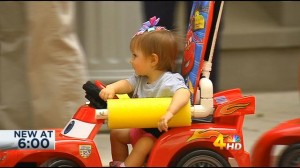The Inman Health Sciences Building became a workshop and playground on Thursday as part of an international project to promote pediatric mobility. University of Delaware physical therapy professor Cole Galloway and his Pediatric Mobility Lab and Design Studio bought to Belmont Go Baby Go, a program that teaches adults how to modify existing toy cars in a few hours to make them functional for children with disabilities.
Eight families and their therapists from Tennessee, Kentucky and Georgia worked alongside Belmont occupational therapy and physical therapy students and alumni to learn how to modify toys and the logistics of the Go Baby Go program. Together, they altered Fisher Price Lightning McQueen red cars with Velcro, PVC pipes, pool noodles and kickboards to create wheelchair-like toys. The cars also function as physical therapy devices to teach strength and balance while allowing the disabled children to socialize with other children their age. Through constraint-induced therapy, the children are motivated to use their weaker muscles to gain independence and operate the toys, which by nature are fun. Buttons were moved so that the toy car moves only when a girl with cerebral palsy holds her head up or a boy with a spinal cord injury stands.
For 1-year-old Paisley Queen, she must engage her weak right hand to move her toy car. She suffered an intrauterine stroke and does not use the right side of her body.
“Hopefully, the car will make her more mobile and force her to use her right arm and eventually her right leg and catch her up with her peers who are crawling and starting to walk. That will be a benefit to us,” said her mom Laura Queen, of Mount Juliet, Tennessee.
Occupational Therapy Assistant Professor Teresa Plummer and Galloway sit on a panel of North American academics writing a position paper on early pediatric mobility to change policy among insurance companies and manufacturers.
“There aren’t wheelchairs this small, and insurance companies won’t pay for it because they don’t think these young children should be mobile. But these cars meet the needs of kids who don’t have access to independent mobility. Socially, they are not with other kids, so cognitively, they don’t develop, and they can’t keep up with their peers,” Plummer said, but she hopes their position paper will transform the industry.
“Go Baby Go is the candy coating to the science behind it, an advocacy program that gets the word out, bringing the latest research into condensed version so that policy makers can get a picture of how much support there is behind pediatric mobility,” said Galloway, who added that in five years, he hopes the industry will fill the gap. Go Baby Go toy cars cost only about $200, and because infants and young children weigh little, they can use devices made of plastic parts and small batteries.
“There is nothing magical about what we did today. You can’t judge a kid by her head control. With a little PVC and engineering, she can activate her whole body,” Galloway said. “What’s magical is all of you working together in this room. What we have here is easy to copy and paste anywhere,” Galloway said, as he encouraged parents and therapists to share their knowledge and pictures with other special needs families.
“Our ultimate goal is that in communities, people will hook up with others and pass down the devices. That when a child outgrows her car, it goes back to a clinic to be modified and passed to another child,” Plummer said. Belmont students plan to take what they learned to Mexico and Peru and build more Go Baby Go cars while doing summer medical mission work.
“We’ve learned more about pediatric mobility and possibilities for children zero to 3 years old. I’ve learned to engineer things you would not think are modifiable into functional devices for children that need help,” said third-year occupational therapy student Sara Harper.
Middle Tennessee-based Permobil, the leading provider of power wheelchairs with mobility products, funded the two-day workshop and sent engineers to observe the process for research and development. The company also unveiled its prototypes to parents and solicited their feedback on cost, functionality, safety features and aesthetics. Pixar also filmed the workshop on campus for a documentary on pediatric mobility and the Go Baby Go program.
Nashville’s WSMV Channel 4 was also on hand to report the story. . . . . .
http://www.wsmv.com/story/25469941/go-baby-go-devices-help-children-with-disabilities-become-mobile

